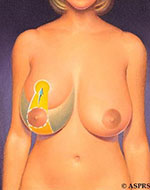Breast Reduction
Am I A Candidate?
Candidates for this procedure include women who are seeking alleviation of symptoms related to their very large and pendulous breasts. These symptoms include back, shoulder, and neck pain, as well as skin irritation underneath the breasts. Breast reduction is usually performed after the breasts have developed fully.
How Is Surgery Performed?
 Although there are many techniques for breast reduction, they commonly involve incisions around the new areola, a vertical incision down to the breast crease, and another one that actually follows the length of the breast crease itself. Excess glandular breast tissue and skin are removed. The position of the nipple is also elevated or lifted. Occasionally, liposuction is performed to reduce the excess tissue in the underarm. If the breasts are extremely large and pendulous, the entire nipple and areola may need to be removed and grafted onto the newly reconstructed breasts. Nipple sensation will therefore be lost in this circumstance.
Although there are many techniques for breast reduction, they commonly involve incisions around the new areola, a vertical incision down to the breast crease, and another one that actually follows the length of the breast crease itself. Excess glandular breast tissue and skin are removed. The position of the nipple is also elevated or lifted. Occasionally, liposuction is performed to reduce the excess tissue in the underarm. If the breasts are extremely large and pendulous, the entire nipple and areola may need to be removed and grafted onto the newly reconstructed breasts. Nipple sensation will therefore be lost in this circumstance.
What Are The Risks?
With any surgery, there is always the risk of complications, including bleeding, infection, or reactions to anesthesia. The incisions will produce permanent scars, although they are covered easily by a bra or bathing suit. Asymmetry with respect to size as well as nipple position can occur. There is also a chance of losing nipple sensation. Future breast feeding may also not be possible. On rare occasion, the nipple and areola may lose enough of its blood supply so that it will die if left untreated. A nipple graft or reconstructive procedure may be required in this circumstance. You can reduce your risk for complications by following your plastic surgeon’s advice and instructions closely before and after surgery.
What Can I Expect?
Along with dressings, a compression bra or elastic bandages are used immediately after surgery. Drains are also placed into each breast to drain the excess fluid build-up. These drains are removed at about one week. Bruising and swelling usually subside after a couple of weeks. The stitches are removed in one to three weeks. Some mild drainage and crusting can occur along the incision lines. Random tingling sensations, occasional shooting pains, and numbness may occur and last for several months. The redness of the scars may last for up to a year. Lifting and strenuous activity are to be avoided for 6 weeks.
How Long Do The Results Last?
Six months to a year may past before your breasts stabilize in shape. Although the changes in your breast are permanent, pregnancy, gravity and age, weight fluctuations, and hormonal changes can still affect the shape of your breasts. Nevertheless, your body will achieve a more proportioned appearance, and your clothes will fit and look better on you. Most patients are happy with the decrease or alleviation of their previous symptoms associated with very large breasts.
